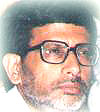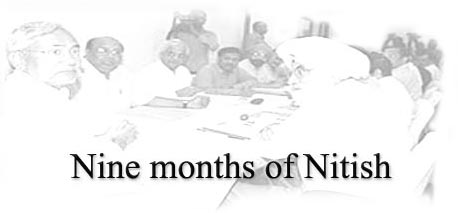On
August 24, Nitish Kumar completed nine months in office
as the Chief Minister of Bihar. Just a day before, the
HSBC (Hongkong and Shanghai Banking Corporation) inaugurated
its 44th branch in Patna and, two days later, the tenders
for building the roads of capital town of Patna was
opened. In the presence of Naina Lall Kidwai, the high
profile CEO of HSBC, its branch was opened by the British
High Commissioner Sir Michael Arthur. In case of the
tenders, contrary to the initial apprehension, out of
the eleven nationally reputed builders who had bought
the tender forms, two companies (Tantia Group Construction
Ltd. and Consortium of DS Constructions and P&M
Infrastructure) actually submitted the tender, each
with a deposit of Rs.1.40 crore as earnest money for
a Rs.140 crore road building project. These two apparently
unconnected events, though not very dramatic, indicate
the initial outcome of sustained re-branding of Bihar
in the last nine months, resulting in regular trekking
of dramatis personae of national/global economic and
financial firmament for getting connected to the state.
Nitish Kumar is possibly the only public figure in recent
period in India who is engaged in two onerous tasks
- first, re-branding of the state from a very negative
image through the elite prism of administrative, industrial,
planning and much talked about tax reform and, second,
providing slew of subaltern centric steps like reservations
for the lower backwards in Panchayat election, Land
Reform Commission, Commission on Common School System,
Farmer's Commission, massive thrust to the Sarva Shiksha
Abhiyan and revitalizing the state's educational agenda.
Apart from charting out the developmental policy contours
to rejuvenate the economy, he is also trying to resurrect
the moribund state structure and create commensurate
conditions for emergence of institutions to provide
sustenance to quality governance. For enabling Bihar
to emerge as a front ranking state, various specialised
human resource institutions are being planned, which
will provide higher education opportunities within the
state and also stop outflow of resources through student
migrant. For example, the just created Chanakya National
Law University at Patna will not only provide much needed
integration with the international legal epistemology
but also produce graduates who will aid and create ambiance
at every level of governance. Now that World Trade Organisation
(WTO) is there, gone are the days when industry or agriculture
in India could flourish in a protected market, without
the need for international legal literacy. So agenda
for development in a peripheral economy like Bihar with
a very limited market and literacy is a formidable one.
In
view of the enormity of the task and the nature of the
existing social support, Nitish Kumar is essentially
working out, in last nine months, the nuts and bolts
of operational parts of policy initiative, which was
electorally fine tuned in the last assembly election.
The victorious coalition was possibly the broadest possible
social coalition, incorporating extreme social groups
from elite at one hand to the very subaltern at the
other. Working out the programmatic thrust of this coalition
in such a short time is not a mean achievement. It is
to be borne in mind that Nitish Kumar is functioning
with several handicaps. He has no advantage of history
to flaunt, unlike in many of the southern and western
states in the realm of growth and developmental icons.
He does not have a well oiled party organization, like
CPI(M) in West Bengal, which can act as a social shock
absorber or foot soldiers for implementing the governmental
programme, working as a outside pressure group. The
absence of a corporate sector and a development oriented
civil society is another major constraint for re-branding
the state. Thus the success of the developmental strategy
here rests entirely on the bureaucracy which falls short
on the ground of both capacity and commitment. However,
these handicaps gets partly compensated by a so far
non-hostile central government and the full support
of the President of India for Bihar. For example, P.
Chidambaram's visit to Bihar, his first to any Hindi
heartland state, was sort of a 'political coup' on the
part of Nitish Kumar. Even within the state, the NDA
is functioning quite cohesively. The Deputy Chief Minister,
Sushil Kumar Modi, has played a decisive role in this
cohesion. He is also the co-architect for initiating
several tax reforms. He has not allowed any one-up-manship
or ideological predilection to sour relation with the
Chief Minister.
|
The task of building Bihar, however, needs not only
cohesion within NDA, but a still broader provincial
consensus. Bihar has never pursued a cohesive and inclusive
agenda of development. This was primarily due to the
absence of a viable, forward looking and inclusive state
structure. Further, the feudal pattern of appropriation
also came in the way of a formation of an authentic
elite. These limitations had direct consequence in the
quality of governance in the post-independence Bihar.
Infact, the foundation laid in the fifties by the then
ruling elite determined the subsequent trajectory of
underdevelopment. In the recent past, while the society
got increasingly democratized, the ram shackled elites
of the state increasingly gave up its 'ownership'. In
the process, functioning of the state further nosedived.
Will Nitish Kumar will be able to bring back the sense
of ownership of the elite for the state, without altering
the process of democratization which the state has already
undergone ? To what extent the subaltern will remain
part of this ruling coalition without allowing any enchroachment
in their already won democratic space? For Nitish Kumar,
the nine months have been very tight rope walking, but
his political and administrative brilliance will be
measured ultimately in terms of his policy of 'growth'
with 'justice' without abandoning the 'coalition of
extreme'.
comment
|
Comments...
Now
it is about time when the efforts claims to have been made by
this CM should be visible.We do not expect miracle but nine months
is good enough time to initiate at least to show some result particularly
in the basic needs of the general public like electricity, road,
policing and administration. Public memory is very short and so
is his patience. CM should remember that it is wafer thin and
if conditions would not ameliorate within the reasonable time
frame people may be constrained to focus his attention again to
a lesser evil than the present one in desperation. Let this CM
not wither away the soft foliage one has started visualizing with
the change of regime. God bless him.
C
S Das
csdas1@gmail.com
|


Dr.
Shaibal Gupta*
Member Secretary,
Asian Development Research Institute (ADRI)
shaibalgupta@yahoo.co.uk
|

